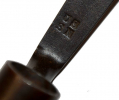site search
online catalog
IDENTIFIED CIVIL WAR CADET MUSKET EX-MOLLUS COLLECTION WITH MATCHING NUMBERED BAYONET

$1,995.00 SOLD
Quantity Available: None
Item Code: 490-3922
This cadet musket came from the January 16, 2021, sale of pieces from the MOLLUS War Library and Museum. The museum of the Military Order of the Loyal Legion of the U.S., the veteran’s organization of former Union officers, was incorporated in 1888 and housed from 1922 in a Philadelphia townhouse. After its closure in 2008 many of the artifacts went to other institutions and the remainder were sold at auction. This musket still retains tags with the museum’s inventory number that should be retained as part of its provenance. It was sold as Lot 53 and described as, “Cadet Musket. Smooth bore percussion probably converted from flintlock. No markings on lock plate. Small oval silver plate engraved “J.C. Guernsey” behind the breech. Brass fittings.” The musket came with its bayonet, still with it, a reused Hall rifle bayonet that was given a rack number “2” near the neck matching numbers on the flat brass barrel bands, including the rear strap of the top band, which has a scalloped edge between the two straps.
This musket is a slightly downsized version of an infantry musket, with a somewhat European look, measures 45 ¼ inches overall and has a .62 caliber barrel that is 32 inches long. We have not taken it apart, but it is typical of those marketed to military academies or the cadet corps of various private schools, arms that were often assembled by dealers from assorted obsolete, surplus, or salvaged parts, combined with elements of imported military arms and some newly made parts or stocks. The cadet muskets of J. Henry & Son of Philadelphia come to mind as an example, though this one is unmarked. It rates good to very good for condition, with smooth brown barrel showing just light salt-and-peppering at the breech, but smooth metal to the lock, and nicely patinated brass. One side screw is an old replacement. The wood to metal fit is tight around the sideplate, lockplate, and buttplate, though the wood shows various dings and pressure dents as might be expected in a cadet musket from handling, with some wear to forestock edges along the barrel and heavy wear to the ramrod channel from repeated drill that must have emphasized drawing and returning the ramrod, which has a trumpet shaped head with brass tip. There are some chips around lock apron, and some slight chips around the breechplug tang. The counterpane has slight rounding to the forward edge and a typical short hairline from the rear lock screw to the barrel breech that is stable. Action functions well; smoothbore has a few rings of built up oil and dirt.
The triggerguard tang has slight finger ridges at rear and a British looking forward finial. The brass mounts overall give it a somewhat Germanic look, but were likely more for eye appeal than anything else. The lock is flat and unmarked, likely acquired by the assembler specifically for these guns. The percussion hammer is a civilian style and the side-lug bolster has no cleanout screw. The flat bands are not meant to be casually removed or jostled loose and are fastened with screws. The bayonet is a surplus Hall rifle bayonet that has been rack numbered on the socket near the neck to match the musket.
Though the wrist escutcheon is likely German silver. The name is professionally engraved. Though part of the museum’s arms collection, the owner was not identified, but is possibly Joseph Colburn Guernsey of Philadelphia (1849-1930.) He became a well-known Philadelphia physician, graduating Princeton in the class of 1870 and Hahneman Medical School in 1872, where he later taught. He became President of the PA Homeopathic Medical Society in 1893 and was also a trustee of Hahneman Medical School. According to one biography, “his early education was obtained in Philadelphia private schools . . .” This would fit with use of the musket in the cadet corps of a private school in early to mid-1860s though we do not find a direct connection with MOLLUS.
Cadet muskets are a specialized collecting field that offers a lot of variety as well as some real rarities. This is a good example with a nicely engraved escutcheon plate indicating a pretty well appointed school. [sr] [ph:L]
DISCLAIMER: All firearms are sold as collector's items only - we do not accept responsibility as to the shooting safety or reliability of any antique firearm. All firearms are described as accurately as possible, given the restraints of a catalog listing length. We want satisfied customers & often "under" describe the weapons. Any city or state regulations regarding owning antique firearms are the responsibility of the purchaser. All firearms are "mechanically perfect" unless noted, but again, are NOT warranted as safe to fire.
~~~~~~~~~~~~~~~~~~~~~~~~~~~~~~~~~~~
THIS ITEM, AS WITH ALL OTHER ITEMS AVAILABLE ON OUR WEB SITE,
MAY BE PURCHASED THROUGH OUR LAYAWAY PROGRAM.
CLICK HERE FOR OUR POLICIES AND TERMS.
THANK YOU
Inquire About IDENTIFIED CIVIL WAR CADET MUSKET EX-MOLLUS COLLECTION WITH MATCHING NUMBERED BAYONET
For inquiries, please email us at [email protected]
Most Popular
Historical Firearms Stolen From The National Civil War Museum In Harrisburg, Pa »
Theft From Gravesite Of Gen. John Reynolds »
Cavalry Carbine Sling Swivel »
Fine Condition Brass Infantry Bugle Insignia »
featured item
HALF-PLATE DAGUERREOTYPE OF C.S. MAJOR GENERAL STEPHEN DODSON RAMSEUR AND C.S. COLONEL FRANK KINCLOCH HUGER AS WEST POINT CADETS BY JAMES EARLE McCLEES, PHILADELPHIA
This important half-plate daguerreotype comes from the collection of the late Bill Turner and shows future Confederate Major General Stephen Ramseur on the left and future Confederate artillery Colonel Frank Huger, son of CS General Benjamin Huger on… (1138-1780). Learn More »




























